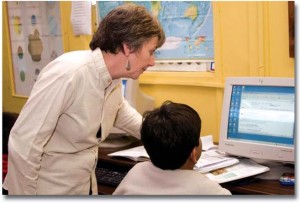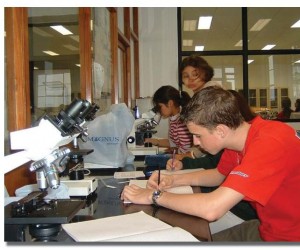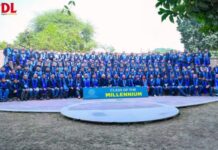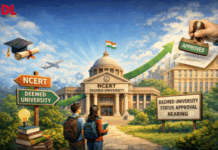New Age Skills at a 152-year-old School
 In 1854, a company of British officers and two American missionaries was formed in Dehra Dun. Concerned for Protestant education for girls, they solicited the help of a group of English women to help staff and manage what was to become Woodstock School. The school after a century of its formation, n 1959, became the third High School outside North America and the first school in Asia to receive US accreditation through the Middle States Association of Colleges and Secondary Schools. In 1990, the Association of Indian Universities recognised the Woodstock Diploma as being equivalent to the Indian school leaving examination, thus allowing graduates to enter Indian universities with greater ease. Today, this Woodstock School in the Indian Himalayas is one of the most highly esteemed international schools in South Asia. In recent time, it has placed a priority on its academic programming with
In 1854, a company of British officers and two American missionaries was formed in Dehra Dun. Concerned for Protestant education for girls, they solicited the help of a group of English women to help staff and manage what was to become Woodstock School. The school after a century of its formation, n 1959, became the third High School outside North America and the first school in Asia to receive US accreditation through the Middle States Association of Colleges and Secondary Schools. In 1990, the Association of Indian Universities recognised the Woodstock Diploma as being equivalent to the Indian school leaving examination, thus allowing graduates to enter Indian universities with greater ease. Today, this Woodstock School in the Indian Himalayas is one of the most highly esteemed international schools in South Asia. In recent time, it has placed a priority on its academic programming with
renovations to classrooms and laboratories, introduced innovations into the academics as well as the campus. Woodstock has an important contribution to make education modern, innovative and independent in India, which is facing a
period of significant challenge, change and opportunity. It has the ability in educational terms to bridge ‘east’ and ‘west’, offering a window for India on the best of international educational practice. It provides a broad liberal education, with the emphasis on innovation, critical thinking, using diverse teaching methodologies and a wide variety of learning resources. Jeffrey Thomas (jeffreythomas@woodstock.ac.in), Academic Technology Coordinator of Woodstock School, Mussoorie UA in India shares the Woodstock experiences of integrating ICTs into the education process, elevating the learning spirit of students of he community
Power School
Woodstock School wasfounded in 1854 in the Landour section of the Mussoorie hill station. An Anglo- Indian English-medium Christian boarding school affiliated with the Church of North India, Woodstock this year is educating students from twenty-seven countries. The school offers both Indian mark sheet and IGCSE (Cambridge), as well as preparation for the U.S. Advanced Placement examinations. Education for a World of Difference, with this motto it is constantly learning, and striving to make Woodstock a better place for learning. In recent years, the school focused on developing a firm technological infrastructure, with computing hardware and network wiring throughout the campus. This momentum is leading to interactive whiteboards, further installations of data projectors in classrooms, and wireless access on campus. The goal is to take the academic initiative in best use of technology. This emphasis is reflected in the school’s recent reorganisation to assign the task to a new faculty member with a position designated specifically to coordinate academic technology. The faculties constantly try finding ways of incorporating technology and computer use into lesson plans. One example is the loaner PC making the rounds – a new ‘tablet’ computer that interprets English handwriting input, and also eases presentations that use a data projector. The presenter can draw notations onto the computer screen, where it will be reflected immediately onto the projector screen, then get saved onto the school network where students can review it later. The school is reviewing course management and portal software and has selected Moodle, that can streamline the way students interact with teachers and encourage collaboration. A few English literature classes have started to use weblogs to post class notes and essays for mutual commentary. A pilot group of teachers has started ‘moodling,’ distributing homework assignments and receiving presentation files via an intranet website. Preparing the students for a more technologically saturated world requires also preparing teachers with the new tools and ensuring that the tools continue to serve the goal – ‘education for a world of difference’. Professional development is crucial to the success of these new tools. Simply placing new equipment on a teacher’s desk does not constitute technology integration –consistent and constant professional support must be provided to ensure that the machines not only turn on, but also fit into lesson plans, and work as reliably as our pencils and erasers and
calculators. or several years, Woodstock has required basic computer competency for graduation, and offered a few courses in computing applications and computer programming. The International Society of Technology Educators (www.iste.org) provides a basic set of guidelines that
serve to ground Woodstock’s academic technology planning. They outline six areas of focus regarding technology in education: operations; ethics; productivity; communications; research; and problem solving. Each of these areas is further elaborated in profiles for student age groups, and teachers and administrators as well. The school is constantly reviewing the course requirements to best fit technology education into multiple curriculum demands. The school is also gradually offering more computing resources to students at residence level, eventually allowing certain students computer access to the network in order to expand availability at peak demand periods.
As independent study opportunities increase, and teachers incorporate new technological capabilities into their esson plans, Woodstock moves toward greater use of laptops in lasses, eventually requiring older students to have computers as they prepare for university. This effort to bring new technology
and better integrate existing technology into the daily academic life is bearing fruit, as Woodstock sends its graduates throughout the globe to make “A World of Difference.”
 European Schoolnet,
European Schoolnet,
together with principal partner Young Digital Planet, a developer and publisher of interactive educational software and technologies, invites teachers and schools to submit their ICT projects to the eLearning Awards. eLearning Awards 2006 Schools, educational institutions and organisations in Europe carrying out primary, secondary or teacher training education are eligible for the eLearning Awards. Projects created by individual teachers are eligible.However, all entries should be associated with a school or other eligible institution. It is possible to nominate a different representative. National educational content providers and similar, or projects run by such institutions/organisations are not eligible. Projects that were awarded eLearning Awards in previous years, projects that are part of European Schoolnet (EUN) are also not eligible. Entries should be submitted in a European language. They should include an informative summary or an abstract in English, German, French, Italian or Spanish. Evaluation is carried out online, CDROMs or printed material will not be considered for evaluation. All material to be evaluated should be online from 13 October to 30 November 2006. Winning entries must be kept online until 31 December 2006. This year’s awards ceremony in Belgium follows those from past years, held in Lisbon, Stockholm, Geneva, Prague and Paris. A total of • 175 000 in prize money has been awarded to winning projects. Entries must be submitted via the eLearning Awards website (http:// elearningawards.eun.org/ww/en/ pub/elearningawards2006/index. htm) on or before 13 October 2006.
























